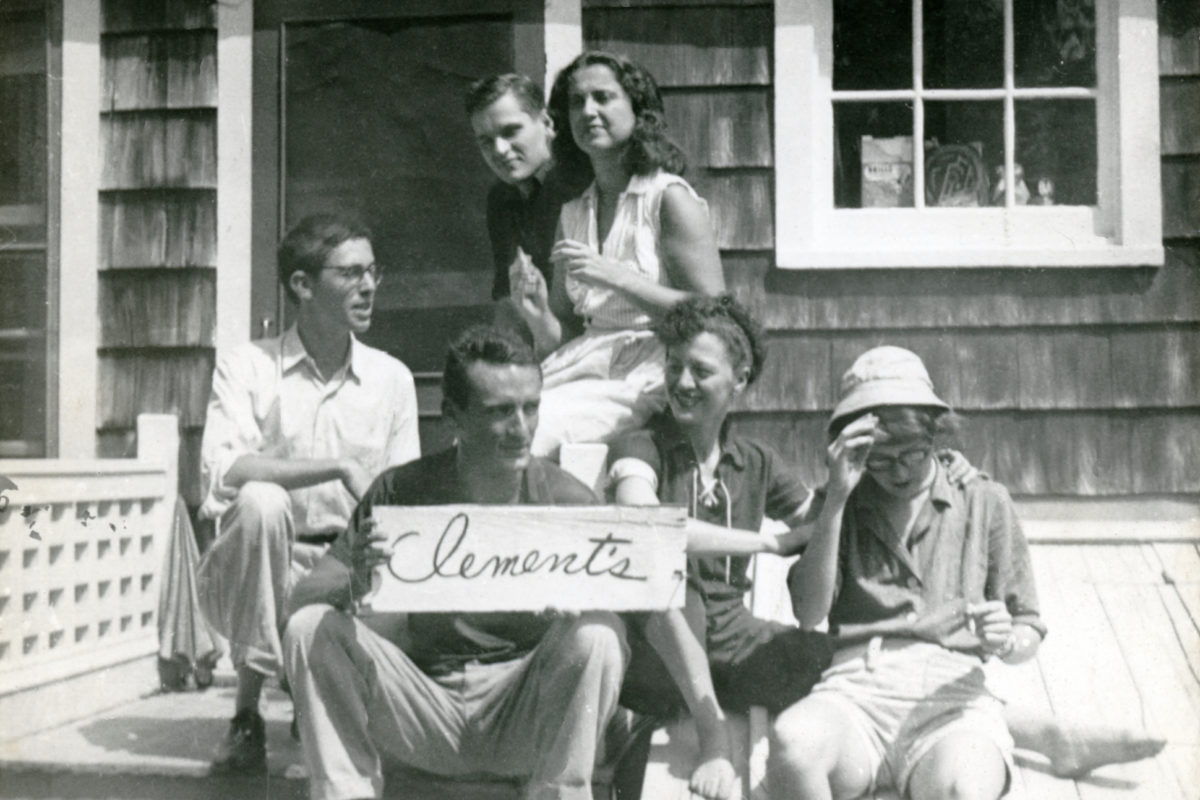New York School poets and painters, (l. to r.): Kenneth Koch, Larry Rivers (holding sign), John Ashbery, Jane Freilicher, Lelia Telberg, and Nell Blaine. Courtesy of the John Ashbery Estate/Flow Chart Foundation.
When discussing poetic movements, literary scholars and fans frequently allude to the New York School. This beloved movement began in the 1960s in New York City, resulting in two generations of poets renowned for their poetic use of the ironic, incorporation of urban life and pop culture, and wild, unexpected linguistic play. The literary tradition has ties to modernism and surrealism, as well a deep relationship with visual art (iconic New York School poet Frank O’Hara worked at the Museum of Modern Art and also published art criticism, and other poets bonded with well-known artists such as Jackson Pollock).
Beyond their glamorous name, which conjures images of bustling and vibrant city life, the New York School poets truly impacted their genre and earned their fame, creating a legacy still felt and built upon today. Prominent poets like Eileen Myles, Rachel Zucker, and Ed Skoog derive inspiration from their origins. Meanwhile, critics like Maggie Nelson continue to expand modern scholarship on the New York School, shedding light on its widely overlooked female poets. Here are four poets to read to get a feel for the New York School style.
Frank O’Hara
O’Hara used insights from music, art, and dance to inform his poetry, leading to his nickname “the poet among painters” and endowing his poetry with a sense of liveliness. He incorporated language from daily conversations, advertisements, and city street signs into his work, an avant-garde approach that helped it reflect and comment on modern life. Oftentimes, he wrote multiple poems a day.
In O’Hara’s poem “Walking,” one of his many published in POETRY, he illustrates the simple act of walking as a multi-sensory experience: “I get a cinder in my eye / it streams into / the sunlight / the air pushes it aside / and I drop my hot dog / into one of the Seagram Building’s fountains.” Building on this sense of place and the rhythm of daily life, O’Hara concludes, “the country is no good for us / there’s nothing / to bump into / or fall apart glassily / there’s not enough / poured concrete / and brassy / reflections / the wind now takes me to / The Narrows / and I see it rising there / New York / greater than the Rocky Mountains.”
Alice Notley
Referred to as a “present-day Homer,” second-generation New York School poet Notley asserts her distinction by bending genre and experimenting with poetry’s narrative qualities. She calls the point of a poem “to find a new beginning,” a goal she exemplifies in her poem “The Goddess Who Created This Passing World.”
“The Goddess who created this passing world / Said Let there be lightbulbs and liquefaction / Life spilled out onto the street, colors whirled / Cars & the variously shod feet were born / And the past & future & I born too.” Notley also embraces the New York School poets’ affinity for other art forms, putting them in this same sacred realm: “forever was I / Meant by her to recognize a painting / As beautiful or a movie as stunning / And to adore the finitude of words / And understand as surfaces my dreams / Know the eye the organ of affection / And depths to be inflections / Of her voice & wrist & smile.”
Bernadette Mayer
Mayer’s work combines poetry, prose, and sometimes photography, leading critics to point out its ability to blur boundaries in exciting, innovative ways. Her stream-of-consciousness work brings a detailed, reverent observation of everyday life. Mayer calls her poem “[Sonnet] You jerk you didn’t call me up,” a sonnet, but relaxes the form to account for more natural and spontaneous language.
“I’m through with you bourgeois boys,” Mayer laments. “All you ever do is go back to your ancestral comforts / Only money can get — even Catullus was rich but / Nowadays you guys settle for a couch / By a soporific color cable t.v. set / Instead of any arc of love, no wonder / The G.I. Joe team blows it every other time / Wake up! It’s the middle of the night / You can either make love or die at the hands of the Cobra Commander.”
Following her tendency to emulate different genres, Mayer ends the poem with a choose-your-own-adventure twist: “To make love, turn to page 121. / To die, turn to page 172.”
John Ashbery
Ashbery ranks among the most well-known American poets, earning himself the Pulitzer Prize, the Yale Younger Poets Prize, and the National Book Award. Ashbery’s poetry takes inspiration from abstract art, rejecting neat patterns and forms in favor of a chaotic style he said more accurately reflects real life. Devoid of clean-cut meaning and themes, some critics call Ashbery’s work a meditation on “anything and everything.”
These characteristics can be seen in the opening stanza of Ashbery’s multi-paged poem “Fragment”: “The last block is closed in April. You / See the intrusions clouding over her face / As in the memory given you of older / Permissiveness which dies in the / Falling back toward recondite ends, / The sympathy of yellow flowers. / Never mentioned in the signs of the oblong day / The saw-toothed flames and point of other / Space not given, and yet not withdrawn / And never yet imagined: a moment’s commandment.”
Want to write like a New York School poet? For a fun, innovative prompt, try taking a free, virtual tour of the Guggenheim or the Met. Write a poem based on a work of art that speaks to you, and don’t hold back the color or distinct voice of your writing.




